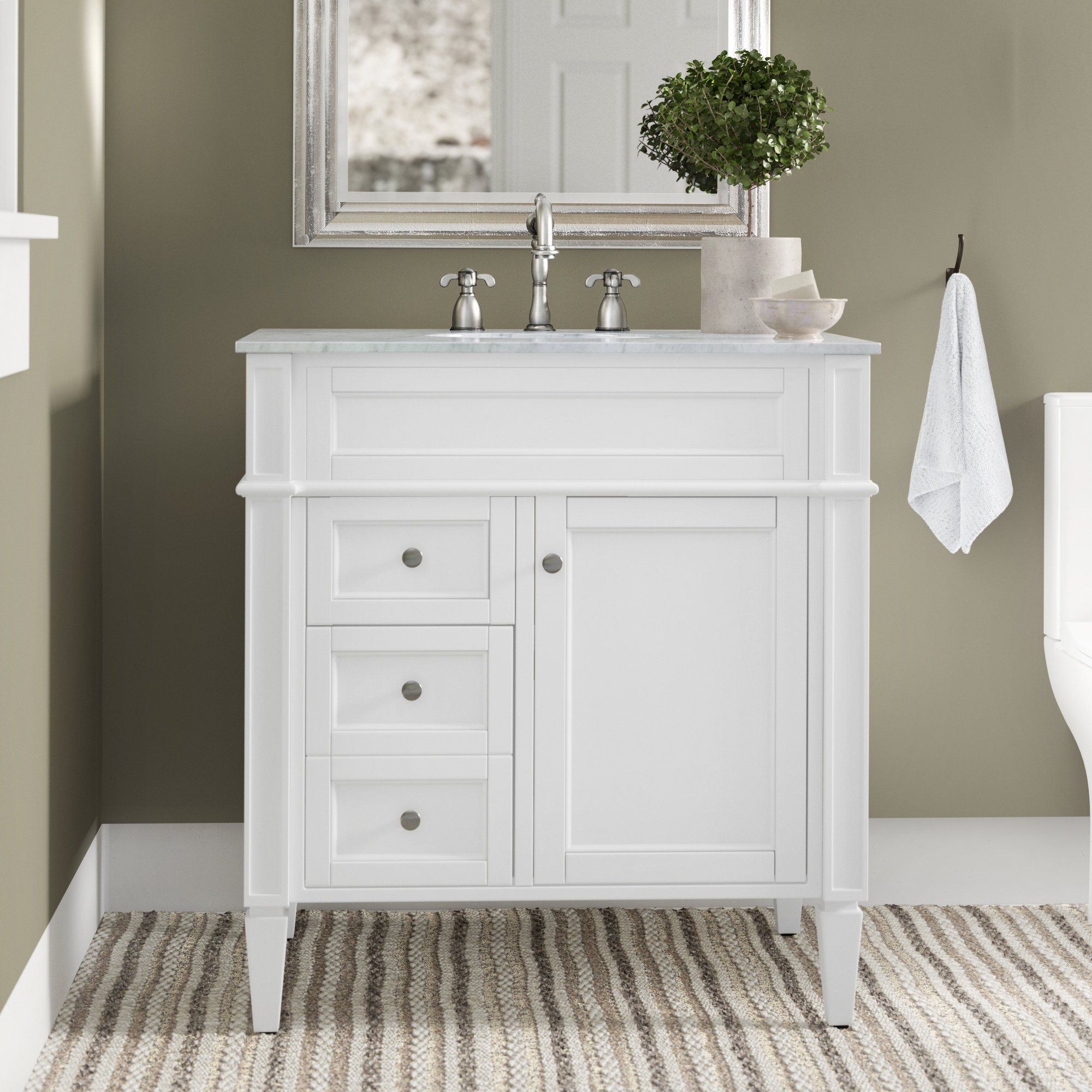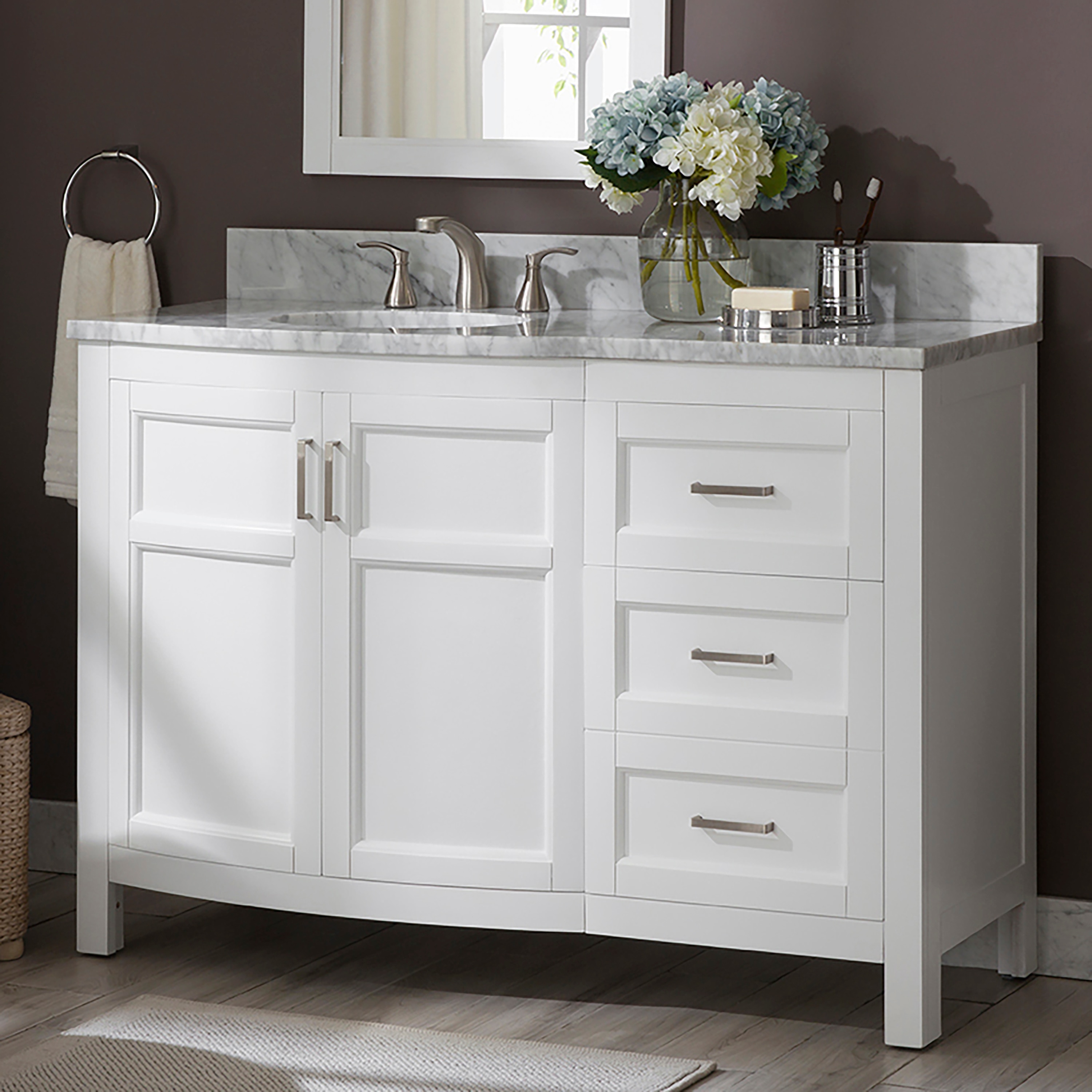31 Inch Bathroom Vanity
A 31-inch bathroom vanity is a popular choice for smaller bathrooms, offering a balance between functionality and space utilization. However, it’s important to consider its advantages and disadvantages before making a decision.
Advantages and Disadvantages of a 31-Inch Bathroom Vanity
A 31-inch bathroom vanity provides ample storage space for toiletries and other bathroom essentials. It can also accommodate a single sink, making it suitable for smaller bathrooms.
- Advantages:
- Space-Saving: A 31-inch vanity fits well in smaller bathrooms, maximizing space for other bathroom fixtures and features.
- Functional Storage: It offers sufficient storage space for toiletries, towels, and other bathroom essentials.
- Affordable: 31-inch vanities are generally more affordable than larger vanities.
- Disadvantages:
- Limited Counter Space: The limited countertop space may not be sufficient for larger bathroom essentials or for multiple users.
- Less Versatility: A 31-inch vanity may not be suitable for larger bathrooms or for families with multiple members.
Vanity Styles for a 31-Inch Bathroom Vanity
A 31-inch vanity can be incorporated into various bathroom designs. The style you choose should complement the overall aesthetic of your bathroom.
- Modern: Modern vanities often feature sleek lines, minimalist designs, and a focus on functionality. A 31-inch modern vanity can be a stylish addition to a contemporary bathroom.
- Traditional: Traditional vanities typically feature ornate details, classic designs, and warm finishes. A 31-inch traditional vanity can create a timeless and elegant look in a classic bathroom.
- Farmhouse: Farmhouse vanities are characterized by their rustic charm and natural materials. A 31-inch farmhouse vanity can add a touch of warmth and authenticity to a country-inspired bathroom.
Design Tips for Incorporating a 31-Inch Vanity
A 31-inch vanity can be effectively incorporated into various bathroom layouts. Here are some design tips to help you create a functional and stylish bathroom:
- Maximize Vertical Space: To compensate for limited countertop space, consider utilizing vertical storage solutions such as wall-mounted shelves or a medicine cabinet.
- Choose a Compact Sink: Opt for a compact sink that fits comfortably within the vanity’s dimensions, leaving ample space for other bathroom fixtures.
- Create Visual Interest: Use mirrors, lighting, and decorative accents to create visual interest and enhance the overall aesthetic of the bathroom.
Features and Functionality

A 31-inch bathroom vanity is a great choice for smaller bathrooms, offering a balance of style and functionality. It’s important to choose a vanity that meets your needs and complements your bathroom design. Let’s explore some key features and functionalities to consider.
Cabinet Configurations
The cabinet configuration of a vanity is a major factor in its functionality. You can choose from vanities with drawers, doors, or a combination of both. Drawers provide easy access to your toiletries and storage items, while doors offer a more traditional look and can hide clutter. Open shelves offer a more minimalist aesthetic and provide quick access to items you use frequently.
- Drawers: Drawers are ideal for storing smaller items like toiletries, makeup, and hair styling tools. They offer easy access and keep everything organized. Many vanities feature soft-close drawers, which prevent slamming and ensure a quiet experience.
- Doors: Doors provide a more traditional look and can hide clutter. They are ideal for storing larger items like towels, linens, and cleaning supplies.
- Open Shelves: Open shelves offer a more minimalist aesthetic and provide quick access to items you use frequently. They can be used to display decorative items or store towels and toiletries.
Countertop Materials
The countertop material is another important consideration. It should be durable, easy to clean, and complement the overall bathroom design. Common countertop materials for bathroom vanities include:
- Granite: Granite is a natural stone that is known for its durability and beauty. It comes in a wide variety of colors and patterns, so you can find a style that matches your bathroom décor.
- Marble: Marble is another natural stone that is known for its elegance and beauty. It is softer than granite, so it is more susceptible to scratches and stains. However, it is still a popular choice for bathroom vanities.
- Quartz: Quartz is an engineered stone that is made from crushed quartz crystals and resin. It is highly durable, stain-resistant, and non-porous. Quartz is available in a wide range of colors and patterns.
- Laminate: Laminate is a more affordable option than natural stone or quartz. It is available in a variety of colors and patterns, but it is not as durable as other materials.
Sink Styles
The sink style is an important part of the vanity’s functionality. It should be easy to clean and complement the overall design. Common sink styles for bathroom vanities include:
- Undermount Sink: An undermount sink is mounted below the countertop, creating a seamless and elegant look. This style is easy to clean and provides a larger counter space.
- Vessel Sink: A vessel sink sits on top of the countertop and is a popular choice for modern bathrooms. It offers a unique and stylish look, but it can be more difficult to clean than other sink styles.
- Drop-in Sink: A drop-in sink is installed into a cutout in the countertop. It is a simple and affordable option, but it can create a less elegant look than other sink styles.
Storage Space
A 31-inch bathroom vanity may be compact, but it can still offer ample storage space. Consider the following:
- Maximize Drawer Space: Utilize drawer organizers or dividers to maximize storage space within drawers.
- Utilize Open Shelves: Open shelves can be used to store towels, toiletries, and other items that you frequently use.
- Add a Medicine Cabinet: A medicine cabinet above the vanity can provide additional storage space for toiletries, medications, and other items.
Hardware Finishes, 31 inch bathroom vanity with drawers
The hardware finish can complement the overall bathroom design. Consider the following:
- Brushed Nickel: Brushed nickel is a popular choice for bathroom hardware. It offers a sleek and modern look.
- Polished Chrome: Polished chrome is another popular choice for bathroom hardware. It offers a classic and elegant look.
- Oil Rubbed Bronze: Oil rubbed bronze is a more rustic and traditional option. It can add a touch of warmth and character to the bathroom.
Installation and Maintenance: 31 Inch Bathroom Vanity With Drawers

Installing and maintaining a 31-inch bathroom vanity isn’t rocket science, but it does require some basic knowledge and careful execution. Here’s a breakdown of the steps involved, from setup to upkeep.
Installation Process
Installing a 31-inch bathroom vanity typically involves a few key steps. It’s important to note that the exact process may vary depending on the specific model and your bathroom’s configuration. However, the general steps Artikeld below should provide a good starting point.
- Prepare the Area: Before starting, ensure the area where the vanity will be installed is clear of any obstacles. This includes removing any existing fixtures or cabinets, and clearing out any debris or clutter.
- Install the Vanity Base: The base of the vanity typically comes pre-assembled. You’ll need to secure it to the floor using screws or bolts. This is often done through pre-drilled holes in the base.
- Connect Plumbing: Connect the vanity’s plumbing lines to the existing water supply. This usually involves attaching flexible supply lines to the faucet and sink.
- Install the Sink and Faucet: Install the sink onto the vanity top, ensuring it’s securely fastened. Then, install the faucet, following the manufacturer’s instructions.
- Connect Electrical: If your vanity has electrical outlets, you’ll need to connect the wiring. This is typically done by a licensed electrician.
- Install the Mirror and Accessories: Install the mirror and any other accessories, such as towel bars or shelves, according to their respective instructions.
- Final Touches: Once everything is installed, clean the vanity and its surrounding area. Make sure the sink drains properly and that the faucet works as intended.
Maintenance Practices
Keeping your bathroom vanity clean and functional is important for both its aesthetics and longevity. Here are some basic maintenance tips:
- Regular Cleaning: Clean the vanity surface and sink regularly with a mild cleaner and a soft cloth. Avoid abrasive cleaners, as they can scratch the finish.
- Clean the Faucet: Clean the faucet regularly to prevent mineral buildup. Use a soft cloth and a mild cleaner.
- Keep the Drains Clear: Use a drain cleaner to keep the sink drains clear of hair and debris.
- Inspect for Leaks: Check for any leaks around the faucet, sink, or vanity base. Repair any leaks promptly to prevent water damage.
Troubleshooting Common Problems
Most problems with a bathroom vanity are relatively easy to fix. Here are some common issues and solutions:
- Leaking Faucet: A leaking faucet can be caused by worn-out washers or O-rings. Replacing these parts should fix the leak.
- Clogged Drain: A clogged drain can be cleared using a plunger or a drain snake.
- Loose Drawer Slides: Loose drawer slides can be tightened using a screwdriver.
- Damaged Finish: Minor scratches or blemishes on the vanity’s finish can be touched up with a matching paint or sealant.
